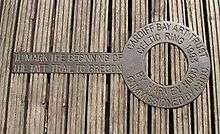Roald Dahl Plass

Roald Dahl Plass is a public space in Cardiff Bay, Cardiff, Wales. It is named after Cardiff-born author Roald Dahl,[1] and is located on the coast along the south of the city centre. The square is home to the Senedd (Welsh Assembly Building) and the Wales Millennium Centre, a performing arts centre. The bowl-like shape of the space has made it a popular amphitheatre for hosting open-air concerts.[1]
Formerly named the Oval Basin or the Bowl to locals, the area was one of the docks for a thriving coal port during the latter half the 19th century and much of the 20th century. Following World War II, the space entered a period of decay and dereliction until the 1980s, when the Cardiff Bay area was regenerated.[2]
The name is a nod to the acclaimed writer's roots (both of Dahl's parents were from Norway) and to the Norwegian seafarers' church which stands nearby. "Plass" is the Norwegian cognate of the English word "place;" in this context the word means square in Norwegian, although the word can also mean "space" or "place." However in Norwegian the name of a square named after a person would correctly be written in the genitive case, in this case as "Roald Dahls plass" (literally, "Roald Dahl's square"). The word "plass" is not capitalized in modern (post-1907) Norwegian.
History

The area was originally all wetlands owned by John Crichton-Stuart, 2nd Marquess of Bute. He was persuaded to finance construction of the dock on his land at a cost of over £ 350,000. The dock opened under the name "West Bute Dock" on 8 October 1839, and was over 1400 yards (1280 m) long and 200 feet (60 m) wide, allowing 300 vessels to berth at any time.[2]
The dock was joined by four others: East Bute Dock, Roath Basin, Roath Dock and Queen Alexandra Dock. Cardiff had become the largest exporter of coal in the world; in 1913, Cardiff exported 10,700,000 tonnes of coal.[3] However, the Great Depression, Second World War and cheap foreign competition all caused massive damage to the Welsh coal mining industry, with the last coal export through the dock taking place in 1964. The dock was filled in to prevent collapse of the surrounding walls.[1]
Design features
Oval Basin
.jpg)
What was known as the Oval Basin was designed by artist William Pye, in conjunction with Nicholas Hare Architects and it opened in April 2000.[4][5][6] A plaque was unveiled 13 July 2002 to commemorate the rename of the Oval Basin to Roald Dahl Plass.
Roald Dahl Plass is today an oval shaped open space surrounded by illuminated pillars and a gravel covering over the original dock area.[1] The place is often used to host concerts and other cultural events, and was a central part of Cardiff's bid for European Capital of Culture status for 2008, although it ultimately lost the bid to Liverpool.[1]
Water Tower
At the north end of the plass is the Water Tower, which stands at approximately 70 feet (21 m) high with an intermittent stream of water running down the metallic fountain. The tower was also designed by Nicholas Hare Architects[5] in conjunction with the sculptor, William Pye.[7]
The tower has also become known as the "Torchwood Tower" (and postcards published using that name),[8] because it marked the location and entrance of the fictitious 'Torchwood Hub' of the BBC television Doctor Who spin-off series, Torchwood.[9]
Doctor Who and Torchwood
Roald Dahl Plass first appears in "Boom Town", an episode of the long running, sci-fi drama Doctor Who. In the show's universe, a "spatial-temporal" rift runs through Cardiff. The plaza later appears in Doctor Who's spin-off series Torchwood. The fictional Torchwood Institute has one of its headquarters, Torchwood Three, based under the square, to monitor alien activity through the rift. The Water Tower has prominently featured in both of the BBC Wales flagship shows. The base of the fountain can be seen passing through the building, and one of the paving tiles in the square is a decoy which hides an "invisible lift" leading down to the base.[10] This base was effectively destroyed in Torchwood: Children of Earth but the Plass was seen for a brief moment at the end of the first episode of Miracle Day.
| Views of Roald Dahl Plass | |||||||||||
|---|---|---|---|---|---|---|---|---|---|---|---|
|
See also
References
- 1 2 3 4 5 "Dahl name docks at Cardiff Bay". BBC News. 13 July 2002. Retrieved 24 October 2006.
- 1 2 "Roald Dahl Plass". BBC Wales. Retrieved 24 October 2006.
- ↑ Cardiff Bay, Urban75. Retrieved 24 October 2006
- ↑ "Public Art, The Water Tower". Cardiff Harbour Authority. Archived from the original on 21 August 2009. Retrieved 6 September 2009.
- 1 2 "Public art in and around Cardiff Bay". Cardiff Harbour Authority. Retrieved 12 March 2008.
- ↑ "Oval Basin". Nicholas Hare Architects LLP. Archived from the original on 20 March 2015. Retrieved 12 March 2008.
- ↑ "Cardiff Public Art Register" (pdf). Cardiff Council. 2011: 51. Retrieved 25 January 2015.
- ↑ Schofield, John, ed. (2014), Who Needs Experts?: Counter-mapping Cultural Heritage, Ashgate Publishing, p. 215, ISBN 978-1-4724-0178-6
- ↑ "Talks held over Torchwood exhibit". BBC News. 8 June 2009. Retrieved 25 January 2015.
- ↑ James, David (17 April 2006). "Dr Who spin-off based in Bay". South Wales Echo.
External links
-
 Media related to Roald Dahl Plass at Wikimedia Commons
Media related to Roald Dahl Plass at Wikimedia Commons - Roald Dahl Plass on Google Maps
Coordinates: 51°27′50.14″N 3°9′51.11″W / 51.4639278°N 3.1641972°W




